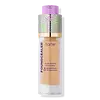Clinique Even Better Refresh Hydrating and Repairing Makeup Versus Tarte Foundcealer Multi-Tasking Foundation Broad Spectrum SPF 20
What's inside
What's inside
 Key Ingredients
Key Ingredients

 Benefits
Benefits

 Concerns
Concerns

 Ingredients Side-by-side
Ingredients Side-by-side

Water
Skin ConditioningDimethicone
EmollientMethyl Trimethicone
Skin ConditioningTrimethylsiloxysilicate/Dimethiconol Crosspolymer
Butylene Glycol
HumectantPhenyl Trimethicone
Skin ConditioningNeopentyl Glycol Diheptanoate
EmollientNiacinamide
SmoothingHydroxyethyl Urea
HumectantPPG-12/Smdi Copolymer
EmollientLauryl PEG-9 Polydimethylsiloxyethyl Dimethicone
Skin ConditioningGlycerin
HumectantSodium Polyaspartate
HumectantPEG-10 Dimethicone
Skin ConditioningSigesbeckia Orientalis Extract
Skin ConditioningPolygonum Cuspidatum Root Extract
AntioxidantAcetyl Hexapeptide-8
HumectantSorbitol
HumectantIsopropyl Isostearate
EmollientPPG-15 Stearyl Ether
EmollientMicrococcus Lysate
Skin ConditioningResveratrol
AntioxidantPalmitoyl Hexapeptide-12
Skin ConditioningSalicylic Acid
MaskingCaffeine
Skin ConditioningPolysilicone-11
Sodium Chloride
MaskingTocopheryl Acetate
AntioxidantPolymethyl Methacrylate
Disteardimonium Hectorite
StabilisingDimethicone/PEG-10/15 Crosspolymer
Lecithin
EmollientTriethoxycaprylylsilane
Caprylyl Glycol
EmollientZinc Stearate
Cosmetic ColorantGlyceryl Polymethacrylate
Laureth-7
EmulsifyingTrehalose
HumectantTriethyl Citrate
MaskingSodium Hyaluronate
HumectantDimethicone Silylate
PEG-8
HumectantMagnesium Aluminum Silicate
AbsorbentMethicone
EmollientAlumina
AbrasiveSilica
AbrasivePropylene Glycol Caprylate
Skin ConditioningHexylene Glycol
EmulsifyingXanthan Gum
EmulsifyingDisodium EDTA
BHT
AntioxidantPotassium Sorbate
PreservativePhenoxyethanol
PreservativeMica
Cosmetic ColorantCI 77491
Cosmetic ColorantCI 77492
Cosmetic ColorantCI 77499
Cosmetic ColorantCI 77891
Cosmetic ColorantWater, Dimethicone, Methyl Trimethicone, Trimethylsiloxysilicate/Dimethiconol Crosspolymer, Butylene Glycol, Phenyl Trimethicone, Neopentyl Glycol Diheptanoate, Niacinamide, Hydroxyethyl Urea, PPG-12/Smdi Copolymer, Lauryl PEG-9 Polydimethylsiloxyethyl Dimethicone, Glycerin, Sodium Polyaspartate, PEG-10 Dimethicone, Sigesbeckia Orientalis Extract, Polygonum Cuspidatum Root Extract, Acetyl Hexapeptide-8, Sorbitol, Isopropyl Isostearate, PPG-15 Stearyl Ether, Micrococcus Lysate, Resveratrol, Palmitoyl Hexapeptide-12, Salicylic Acid, Caffeine, Polysilicone-11, Sodium Chloride, Tocopheryl Acetate, Polymethyl Methacrylate, Disteardimonium Hectorite, Dimethicone/PEG-10/15 Crosspolymer, Lecithin, Triethoxycaprylylsilane, Caprylyl Glycol, Zinc Stearate, Glyceryl Polymethacrylate, Laureth-7, Trehalose, Triethyl Citrate, Sodium Hyaluronate, Dimethicone Silylate, PEG-8, Magnesium Aluminum Silicate, Methicone, Alumina, Silica, Propylene Glycol Caprylate, Hexylene Glycol, Xanthan Gum, Disodium EDTA, BHT, Potassium Sorbate, Phenoxyethanol, Mica, CI 77491, CI 77492, CI 77499, CI 77891
Titanium Dioxide 7.47%
Cosmetic ColorantZinc Oxide 4.75%
Cosmetic ColorantWater
Skin ConditioningPhenyl Trimethicone
Skin ConditioningButylene Glycol
HumectantDimethicone
EmollientButylene Glycol Dicaprylate/Dicaprate
EmollientButyloctyl Salicylate
Skin ConditioningCyclohexasiloxane
EmollientCetyl PEG/PPG-10/1 Dimethicone
EmulsifyingBis-Diglyceryl Polyacyladipate-2
EmollientAluminum Hydroxide
EmollientMethyl Methacrylate Crosspolymer
Orbignya Oleifera Seed Oil
EmollientPolypropylsilsesquioxane
Sodium Chloride
MaskingStearic Acid
CleansingPolyglyceryl-4 Isostearate
EmulsifyingHexyl Laurate
EmollientDimethicone/Vinyl Dimethicone Crosspolymer
Skin ConditioningCalcium Stearate
Cosmetic ColorantDisteardimonium Hectorite
StabilisingTriethoxycaprylylsilane
Sodium Benzoate
MaskingPotassium Sorbate
PreservativeTocopherol
AntioxidantPolyhydroxystearic Acid
EmulsifyingHelianthus Annuus Seed Oil
EmollientEthylhexyl Palmitate
EmollientIsopropyl Myristate
EmollientIsostearic Acid
CleansingLecithin
EmollientDisodium EDTA
Cyclopentasiloxane
EmollientPolyglyceryl-3 Polyricinoleate
EmulsifyingKaolin
AbrasiveCyclotetrasiloxane
EmollientPhenoxyethanol
PreservativeSodium Hyaluronate
HumectantEthylhexylglycerin
Skin ConditioningHydrolyzed Hyaluronic Acid
HumectantIron Oxides
Titanium Dioxide 7.47%, Zinc Oxide 4.75%, Water, Phenyl Trimethicone, Butylene Glycol, Dimethicone, Butylene Glycol Dicaprylate/Dicaprate, Butyloctyl Salicylate, Cyclohexasiloxane, Cetyl PEG/PPG-10/1 Dimethicone, Bis-Diglyceryl Polyacyladipate-2, Aluminum Hydroxide, Methyl Methacrylate Crosspolymer, Orbignya Oleifera Seed Oil, Polypropylsilsesquioxane, Sodium Chloride, Stearic Acid, Polyglyceryl-4 Isostearate, Hexyl Laurate, Dimethicone/Vinyl Dimethicone Crosspolymer, Calcium Stearate, Disteardimonium Hectorite, Triethoxycaprylylsilane, Sodium Benzoate, Potassium Sorbate, Tocopherol, Polyhydroxystearic Acid, Helianthus Annuus Seed Oil, Ethylhexyl Palmitate, Isopropyl Myristate, Isostearic Acid, Lecithin, Disodium EDTA, Cyclopentasiloxane, Polyglyceryl-3 Polyricinoleate, Kaolin, Cyclotetrasiloxane, Phenoxyethanol, Sodium Hyaluronate, Ethylhexylglycerin, Hydrolyzed Hyaluronic Acid, Iron Oxides
Ingredients Explained
These ingredients are found in both products.
Ingredients higher up in an ingredient list are typically present in a larger amount.
Butylene Glycol (or BG) is used within cosmetic products for a few different reasons:
Overall, Butylene Glycol is a safe and well-rounded ingredient that works well with other ingredients.
Though this ingredient works well with most skin types, some people with sensitive skin may experience a reaction such as allergic rashes, closed comedones, or itchiness.
Learn more about Butylene GlycolDimethicone is a type of synthetic silicone created from natural materials such as quartz.
What it does:
Dimethicone comes in different viscosities:
Depending on the viscosity, dimethicone has different properties.
Ingredients lists don't always show which type is used, so we recommend reaching out to the brand if you have questions about the viscosity.
This ingredient is unlikely to cause irritation because it does not get absorbed into skin. However, people with silicone allergies should be careful about using this ingredient.
Note: Dimethicone may contribute to pilling. This is because it is not oil or water soluble, so pilling may occur when layered with products. When mixed with heavy oils in a formula, the outcome is also quite greasy.
Learn more about DimethiconeDisodium EDTA plays a role in making products more stable by aiding other preservatives.
It is a chelating agent, meaning it neutralizes metal ions that may be found in a product.
Disodium EDTA is a salt of edetic acid and is found to be safe in cosmetic ingredients.
Learn more about Disodium EDTADisteardimonium Hectorite comes from the clay mineral named hectorite. It is used to add thickness to a product.
It can also help stabilize a product by helping to disperse other ingredients.
Hectorite is a rare, white clay mineral.
Learn more about Disteardimonium HectoriteLecithin is a term for a group of substances found in the cell membranes of plants, animals, and humans. They are made up of mixture of phospholipids.
This ingredient has emollient and emulsifying properties.
As an emollient, lecithen helps soften the skin and creates a barrier to keep moisture in.
As an emulsifier, it also helps prevent water and oil ingredients from separating. Lecithin can also help ingredients be better absorbed by the skin.
This is because the phospholipids in lecithin produce liposomes. Liposomes help other ingredients get through the skin barrier.
Depending on the source of this ingredient, lecithin may not be fungal acne safe. This is because some sources of lecithin come from soybean oil, which may feed the malassezia yeast that feeds fungal acne.
We recommend reaching out to the brand you are purchasing from to inquire about the source of their lecithin.
Some other names for this ingredient include soy lecithin and deoiled soy lecithin.
Learn more about LecithinPhenoxyethanol is a preservative that has germicide, antimicrobial, and aromatic properties. Studies show that phenoxyethanol can prevent microbial growth. By itself, it has a scent that is similar to that of a rose.
It's often used in formulations along with Caprylyl Glycol to preserve the shelf life of products.
Phenyl Trimethicone is a silicon-based polymer. It is derived from silica.
Phenyl Trimethicone is used as an emollient and prevents products from foaming.
As an emollient, it helps trap moisture in the skin. It is considered an occlusive.
Learn more about Phenyl TrimethiconePotassium Sorbate is a preservative used to prevent yeast and mold in products. It is commonly found in both cosmetic and food products.
This ingredient comes from potassium salt derived from sorbic acid. Sorbic acid is a natural antibiotic and effective against fungus.
Both potassium sorbate and sorbic acid can be found in baked goods, cheeses, dried meats, dried fruit, ice cream, pickles, wine, yogurt, and more.
You'll often find this ingredient used with other preservatives.
Learn more about Potassium SorbateChances are, you eat sodium chloride every day. Sodium Chloride is also known as table salt.
This ingredient has many purposes in skincare: thickener, emulsifier, and exfoliator.
You'll most likely find this ingredient in cleansers where it is used to create a gel-like texture. As an emulsifier, it also prevents ingredients from separating.
There is much debate on whether this ingredient is comedogenic. The short answer - comedogenic ratings don't tell the whole story. Learn more about comegodenic ratings here.
The concensus about this ingredient causing acne seems to be divided. Research is needed to understand if this ingredient does cause acne.
Scrubs may use salt as the primary exfoliating ingredient.
Learn more about Sodium ChlorideSodium Hyaluronate is hyaluronic acid's salt form. It is commonly derived from the sodium salt of hyaluronic acid.
Like hyaluronic acid, it is great at holding water and acts as a humectant. This makes it a great skin hydrating ingredient.
Sodium Hyaluronate is naturally occurring in our bodies and is mostly found in eye fluid and joints.
These are some other common types of Hyaluronic Acid:
Learn more about Sodium HyaluronateTriethoxycaprylylsilane is a silicone used to bind and stabilize ingredients.
As an emulsifier, it helps prevent ingredients from separating. This can help elongate the shelf life of products.
Triethoxycaprylylsilane is often used to coat mineral sunscreens ingredients to help give a better feel. It also helps reduce oxidative stress in sunscreens.
Learn more about TriethoxycaprylylsilaneWater. It's the most common cosmetic ingredient of all. You'll usually see it at the top of ingredient lists, meaning that it makes up the largest part of the product.
So why is it so popular? Water most often acts as a solvent - this means that it helps dissolve other ingredients into the formulation.
You'll also recognize water as that liquid we all need to stay alive. If you see this, drink a glass of water. Stay hydrated!
Learn more about Water